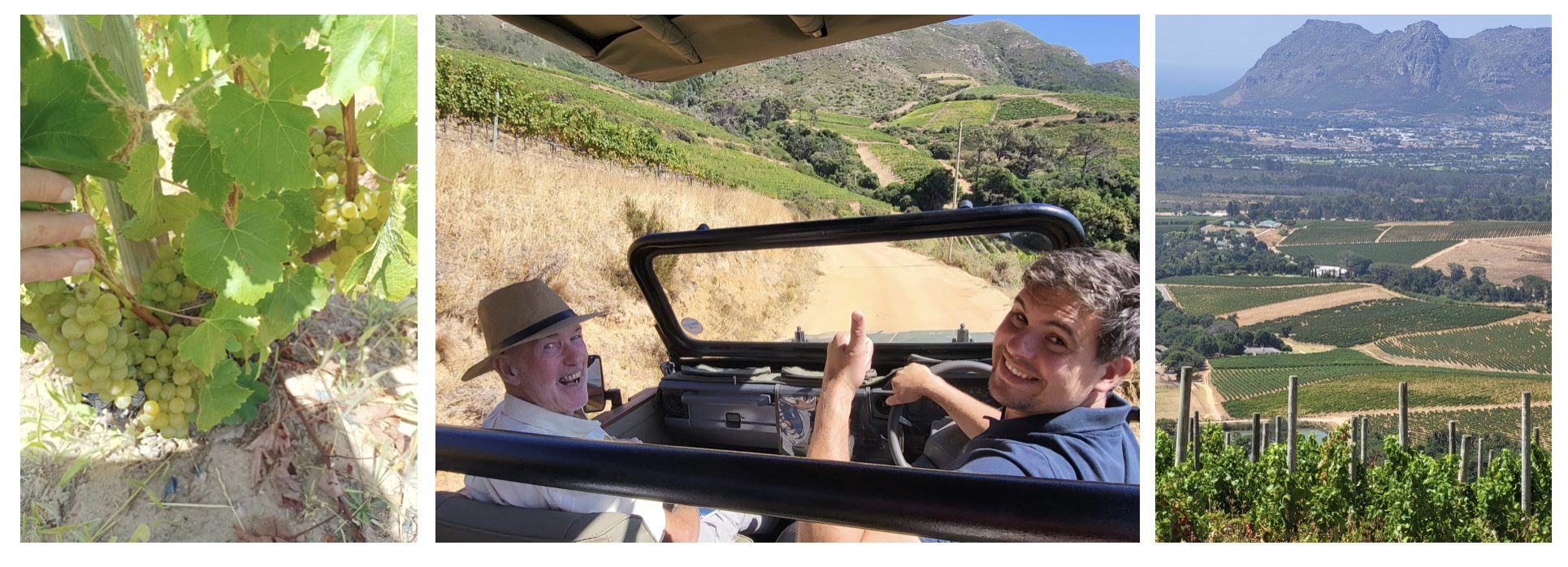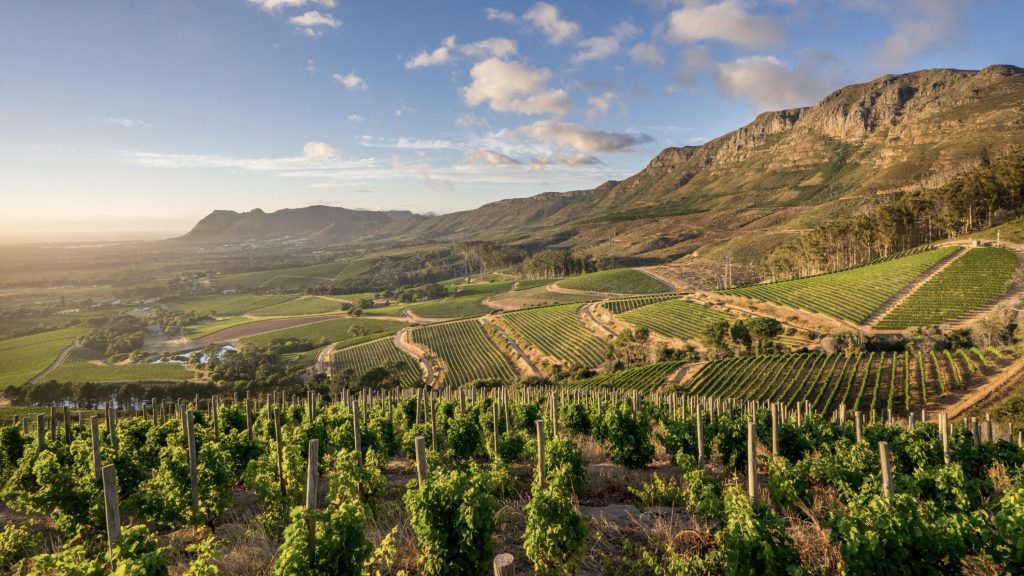Colin Harkness calls in on Klien Constantia, meets winemaker Matt Day, himself fresh from fixing the date for the start of the harvest, and savours the sumptuously sweet Vin de Constance, dry Sauvignon Blancs and a red from Stellenbosch.
Jane Austen is in some rather A-List company when she mentions the luscious dessert wine, Vin de Constance, from Klien Constantia Wine Farm, near Cape Town, South Africa. Napoleon, Washington, Dickens, Queen Elizabeth II and the current Chinese President are just some of the others who have all waxed lyrical about this delicious wine – plus, after our recent visit, my wife, Claire-Marie Soprano, and I!
From November last year to February 2024, we were lucky enough to be on a three-month ocean cruise through the Med, thence to the Suez Canal, the Indian Ocean and then circumnavigating Africa. As you might imagine, there were many highlights on a cruise which takes in: Morocco, Malta, Egypt, Saudi Arabia, Oman, India, Seychelles, Kenya, Madagascar, Mauritius, Zanzibar, Mozambique, South Africa and more. Certainly up there with the very best highlights was our tour and tasting at Klein Constantia! If you ever have the opportunity – go there!
Our visit, which included Miroslav Ilic, the ship’s head sommelier, was kindly arranged by my friend, colleague and fellow Circle of Wine Writers member, Winnie Bowman, Cape Wine Master. Unfortunately, busy as she is, Winnie was only able to take us to the estate, introduce us to the head winemaker, Matt Day, and then speed off to her appointment, as it happens – to examine hopefuls who were attempting to gain the same Brandy Master title that she has held for many years.
Matt had already been out early that Friday morning tasting and analysing grape samples from the various blocks of vines. He was able to tell us, with a look of satisfaction, excitement and a fair amount of trepidation too (considering the hectic, time-consuming and nerve-wracking work about to commence) that the 2024 harvest would start on the Monday*. We were thrilled for him and all who work in such a happy familial atmosphere at this, one of South Africa’s best-known wineries.
As we drove away from the buildings in a four-by-four vehicle similar to those we’d enjoyed so much on game drives earlier in the week, we passed cows, pot-bellied pigs and horses, all of which contribute (you know how!) to the organic and biodynamic philosophy that clearly assists in the production of excellent wines. Our destination was the highest point of the vineyard.
What a captivating view we experienced that gloriously sunny, hot, blue-skied day!
Flying from a group of trees nearby, a majestic Cape Buzzard circled above, and below us (at such an altitude were we), patrolling the vineyards and keeping at bay the grape loving starlings. Pests are kept in check, as far as possible, in a natural way – biodynamic sprays, birds of prey, a family of wild Lynx and so on. Plus, perhaps not so naturally, the regular firing of shotguns harmlessly into the air to, mostly, keep the wild baboons out of the way!
Two or three of the horses also work the land, ploughing the terrain when the ground-covering plants are deemed best to add nutrients to the soil as well as making sure that the soil doesn’t become too compacted because of tractor use. It’s all a splendid sustainable approach which demonstrably works!
Klein Constantia is the oldest ‘New World’ winery, first planted towards the end of the 17th century by the Dutch explorer and settler, Jan van Riebeeck. The original, huge area has since been partitioned and is now home to several independent wine farms. Matt is head winemaker here, as well as at their Stellenbosch sister winery, which is home to their red wine. Klein Constantia is about white wine, including the famed centuries-old pedigree dessert wine, Vin de Constance; as well as their Blanc de Blanc, Cap Classique – the South African name for traditional method sparkling wine.
A Chardonnay Cap Classique
Indeed, it was this fizz that we so enjoyed atop the mountain overlooking the vineyards and further to the ocean, thoughtfully brought by Matt in a perfectly chilled container! Made from Chardonnay, it has had a prolonged period on its lees in the bottle, ensuring that the finished product retains that fresh vitality, so crucial in sparkling wine, whilst displaying mature fruit (initially noticeable green apple, as well as less acidic stewed versions, plus some pear and pastry notes). A medium-length finish and a perfect way to start a tasting.
Back at base, we went past relatively small stainless steel fermentation tanks, French oak barrels of varying sizes plus greater capacity foudres. The winery was starting to become busy with clients, sitting tasting in small, charming alcoves and preparations were being made for tastings with food.
Here, we were introduced to Seb, assistant winemaker, and a local guy, the first in his family to work in wine. Matt had to shoot off, unsurprisingly, considering all the arrangements that had to be made prior to the imminent fully manual-harvesting that was soon to begin. Seb showed us to a private area, where he introduced himself and started the tasting of a further six wines.

Sancerre- and Pouilly-Fumé-esque Sauvignon Blancs and a whole-cluster Chardonnay
Although its most famous wine, Vin de Constance, is made with Muscat grapes, Klein Constantia is mostly about Sauvignon Blanc. There’s some Chardonnay, for the fizz, of course, but also for some still wine which we would be tasting later. Plus, they grow a little Semillon and Riesling too.
Well, Sauvignon Blanc yes, but put all thoughts of New Zealand SB right out of your mind. We are talking here of a very different animal, a far more subtle, French style – in short Sancerre-esque. Indeed, it is the Klein Constantia billionaire owner’s dream to make a ‘South African Sancerre’ – a dream and desire with which Matt and Seb completely concur!
First up was the Klein Constantia Estate Sauvignon Blanc, which accounts for about 50% of total production. Made from about 40 different blocks, it’s a very good representation of the estate. The vines are about 25 years of age and mostly wild yeast is used for its ‘dirty ferment’. This dirty ferment, aka ‘black ferment’, a speciality in years gone by of some French Chardonnay growers, allows for oxygen to be incorporated into the mix. With regular pump-overs too, it also has extended ageing potential, something perhaps not normally associated with SB. It also undergoes a short, partial (25% only) ageing period in 500-litre oak barrels.
This, their entry level wine, is perhaps a bread and butter wine designed to give tasters an idea of the Klein Constantia philosophy, whilst keeping slightly in touch with the New Zealand big-fruit and big-selling approach. A compromise, if you will.
However, Matis, our next wine, pulls no punches. It’s far away from the extrovert NZ style, albeit that there’s a touch of perhaps under ripe gooseberry fruit on the nose. There is a pleasing minerality about the wine, some wet stone (granite more like, there being a large proportion of nearby Table Mountain granite in the soils here) and some green herbs. Dry as you like – a top aperitif wine, but drink it also with salads, fish and seafood. It has presence on the palate following its 10 months in used French oak, and a long finish.
Matt and Seb have worked this wine in collusion with their friends in Sancerre. A dirty ferment again with no sulphur being added. It appears to be exactly what is required – a South African ‘Sancerre’. Lovely – we bought several bottles!
Next up was Clara, 2022. Made in the Pouilly-Fumé style, this wine comes from older vineyards, some of which are comprised of bush vines, and is produced from only the free-run juice which has then enjoyed 10 months in Burgundy oak. Only the best five barrels are selected to make this statement wine, resulting in a small production of just 2,500 bottles. At about 500 Rand (€25) only and tasting very well right now, this is a wine to buy and lay down for at least five years – it will be superb!
Their still Chardonnay 2022 was the next wine. It’s a whole-bunch wild ferment in stainless steel tanks, until a certain point when fermentation is concluded in barrel with daily battonage. Using the whole bunch of grapes adds potassium from the stems along with a little oxygen too. This Chardonnay is subtle with background oak and a mid-length. It will pair nicely with white meats, think chicken and turkey in particular, as well as sauced fish. Also, this wine will make a lovely aperitif on warm sunny evenings and with springtime lunches.
A Stellenbosch Sauvignon-Shiraz blend
Anwilka is their red wine offering from the Stellenbosch winery. Cabernet Sauvignon and Shiraz are used for this structured, layered wine. It’s had 14 months in 400-litre barrels (some of which were new) to add complexity, plus balanced aroma and flavour. A wine for South African game, steaks, traditional braai (BBQ) and hearty casseroles. There’s a herb element, as well as earthy mineral notes to add to the dark berry fruit.
The 2020 Vin de Constance was made during the dreadful Covid period when only those who lived on the estate were allowed, by law, to harvest the grapes. This is a natural, sweet wine made from Muscat grapes picked long after the usual harvest has finished. A lengthy hang-time ensures that water content evaporates from the grapes as they bask in Cape sunshine. Super sugars are left giving a final count of 167 grams per litre and 13.9% alc.
A divine finish
Vin de Constance is a divine dessert wine which has the crucial lick of acidity shared by all the great sweet wines of the world. Speaking of which, the world-renowned Yquem is the target style and fame for this wine. Matt has visited the famous French winery and vice versa, a ‘partnership’ that works superbly.
Initial honey and citrus notes are soon joined by green herbs and mineral aromas with some dates and a trace of figs on the palate too. Golden coloured, Vin de Constance, is actually liquid gold. Priced at about €70 for a half bottle, it’s not cheap, but for those special occasions it’s truly wonderful!
*I’m delighted to hear that the harvest referred to above has been very successfully completed and we can therefore look forward to Vintage 2024 with some excitement!

